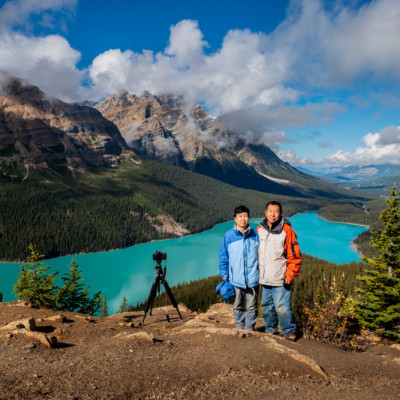SEARCH






|
|
|
|


by Editor Miro Susta
Edited and published by Yvette Depaepe, the 22nd of September 2023
This photo story is somewhat related to ”Incredible Asia“ article, published in 1x Magazine in December 2021.
'Water Village Life' by Kieron Long
I spent nearly 30 years of my life in Malaysia, in a land of contradictions, a land where one can go from the wilderness of the rainforest, where no land roads lead, to the midst of the hi-tech civilisation of a modern city in a single day.
'Reflections' by Miro Susta
In the same day one can admire the skulls of slain enemies tied under the roof of the veranda of an Iban long-house in Sarawak, fishing villages in Sabah and also the skyscrapers of the famous Petronas Twin Towers in Kuala Lumpur.
'The Heart Of the City' by Kok Tien Sang
Malaysia is located in the heart of South-east Asia between Thailand and Singapore.
After the damaging Covid pandemic break, the country is experiencing an economic boom again, it has good infrastructure, enough accommodation for backpackers and discerning travellers, beautiful nature, lovely beaches and mountain ranges and delicious food.
When I suggest to my friends to spend a holiday in a trip to tropical Malaysia, I often get a few surprised looks. Why Malaysia? Is there anything interesting at all? Of course, there is, and one will learn more than you might think at first glance from this article.
Malaysia is just the country, which has only been on the world map as an independent for 66 years, which occupies an area roughly equivalent to Norway, Vietnam or perhaps New Mexico, remains somewhat hidden in many people's imaginations behind some of the other destinations in the region like Thailand or tropical island of Singapore.
The gateway for most tourists is Kuala Lumpur International Airport (KLIA 1 + 2). The super-modern construction of Terminal 1 opened in 1998 and Terminal 2 in 2014.
'Kuala Lumpur by Patricia Soon
KLIA Terminal 1 has been designed to accommodate up to thirty million passengers per year while KLIA Terminal 2 for forty-five million passengers per year.
The tropical climate determines the natural character of the Malaysian landscape, which is located only between about 160 and 700 km north of the equator.
Most of the country was originally covered by rainforests of several types.
As a result of human economic activity, rain forest area has been greatly reduced - this is particularly true for the peninsular part, but even on the island of Borneo the rain forests have not been spared extensive clearing.
'Borneo Rainforest' by Hary Muhammad
Malaysia’s forests are generally moist tropical forests covering approximately twenty million hectares or 60 % of total land.
The forest types present in Malaysia include montane forests, upper-, hill-, and lowland- dipterocarp, fresh water/peat swamp forest, coastal vegetation and mangroves.
The animal world is also very varied, but observing it is much more difficult for a holiday visitor than in the case of trees and many species of tropical plants.
Large mammals are not very numerous in the Malaysian rainforests, even in completely natural conditions, unaffected by humans.
'Sea Turtle at Sipadan' by Yumian Deng
Wild Elephants, Sumatran Rhinos, Malayan Bears, Monkeys, Crocodiles, Lizards, Tigers, Leopards, Turtles and many kinds of snakes live in Malaysia, but encounters with many of them are more than unlikely.
'green' by Fulvio Pellegrini
The most common objects of observation are thus various species of birds and insects.
'Rendezvous' by Antoine Dagobert
For animal lovers, a visit to one of the orangutan rescue and rehabilitation centres in Sabah, on the island of Borneo, is worthwhile.
Malaysia is a federal constitutional elective monarchy consisting of thirteen states and three federal territories, Kuala Lumpur, Putrajaya and Labuan Island.
The eleven states and two components of the Federal Territory (Kuala Lumpur and Putrajaya) lie on the Malay Peninsula and together occupy just over one third of the area of the entire country. Nearly two-thirds of the territory is in East Malaysia on Borneo Island, which consists of two large states (Sarawak and Sabah) and one tiny Federal Territory of Labuan.
'Morning paddle around Timbun Manta island in North Borneo' by Muhammad Rais Sanuasi
The nine peninsular states are still headed by historical hereditary rulers bearing the title of Sultan. These nine rulers always elect one from their midst for a five-year term as "supreme ruler", the Yang di-Pertuan Agong, i.e., the King of Malaysia.
There is always only one candidate - in the first "round", which began in 1957 after independence, the order of states was determined by how long each monarch had already ruled their states, from the oldest in seniority to the youngest. The order has been followed in the second rotation, which began with the tenth king in 1994. The powers of the Malaysian king are not very great, as the executive power is in the hands of the government headed by the prime minister. However, it is the Prime Minister who appoints the King.
Of Malaysia's current population of over thirty-four million, 55% are ethnic Malays, 21% are ethnic Chinese, about 7% are ethnic Indians, and about 8% are indigenous non-Malays concentrated mainly in Sarawak (Iban, Bidajuh and other ethnic groups) and Sabah (Kadazan-Dusun and many others), and 9% are foreigners.
'The World of Sea Gipsy' by Muslianshah Masrie
Malaysian cuisine is based on three main ethnic groups, including Malays, Indians and Chinese. They all have their own specific cuisines that are intertwined with the others. There are also influences from Thailand, Indonesia, Japan, Korea and the Middle East. With this diverse mix, Malaysia is literally a foodie's paradise and eating well here is really no problem.
'Horse mackerel' by Jordan Lye
The weather in Malaysia is temperature stable throughout the year, although the country is classified as a tropical country and the temperature fluctuates in "constant" numbers wherever we move. Expect a daily temperature between 28 - 35°C at any one time, and on any one day.
Malaysia has a lot to offer to visitors - rich culture, modern architecture, mosques and temples, beautiful nature, animals one will not see anywhere else, emerald sea, white beaches and good-hearted people.
Following an outlook of some of the destinations that are worth visiting while travelling in Malaysia.
Kuala Lumpur
Everyone knows the view of the two modern skyscrapers Petronas Towers, 452 m high. Until 2004, they were the tallest buildings in the world.
'Kuala Lumpur' by Robert Fudali
Telecommunications Tower, Menara KL, a 421 m high tower with a viewing platform at 276 m.
Chinatown
A lively Chinatown with a tangle of alleys, colourful houses and a beautiful art-deco market.
'Chinatown' by Fulvio Pellegrini
Kampung Baru
Kampung Baru is a district with a sleepy atmosphere, where you will find traditional Malay wooden houses. The main centre of the city is Merdeka Square (Independence Square) and the area around the Masjid Jamek Mosque.
Also of interest is the old colonial railway station and the nearby Masjid Negara (National Mosque) with its 73-metre-high minaret.
The newest attraction in Kuala Lumpur is the Merdeka 118, the second tallest skyscraper in the world. The tip of the 118-storey building rises 679 metres above the ground and the imposing structure, resembling a sapphire blue crystal, was finished during the last year (2022).
'Blue wonder' by Miro Susta
In terms of height, Merdeka 118 surpasses China's Shanghai Tower (which is 632 metres) and is overshadowed only by the current tallest building, the 828-metre Burj Khalifa in Dubai.
Batu Caves
Hindu cave temple on the outskirts of Kuala Lumpur is accessible by commuter train from Kuala Lumpur. The 43-metre-high golden statue of Murugan, the god of war and victory, is sure to catch the first eye.
From there, there are 272 steps to climb to the entrance of the main cave, which can be quite a challenge in the tropical heat, but it is possible to cool off in the bowels of the limestone mountain.
Putrajaya
Although the status of the capital of Malaysia remains Kuala Lumpur, in the future Putrajaya, just twenty-five kilometres away from Kuala Lumpur, will play a more significant role as a financial and commercial hub of the country.
Putrajaya is a city with many gardens, but also with a sophisticated information and communication network based on modern technology. That is why the Malaysians like to call it the first "Intelligent Garden City". The Prime Minister’s Office dominates the centre of the city, the so-called Perdana Putra, with its large blue dome and the interestingly conceived main mosque - the Putra Mosque (Masjid Putrajaya).
'Masjid Putrajaya' by Jesús M. García
Its architecture incorporates the styles of other Muslim countries: Turkmenistan, Kazakhstan and Morocco. One hundred and sixteen metres high minaret was designed on the model of the minaret of Sheikh Omar Mosque in Baghdad. The mosque is designed for fifteen thousand worshippers.
The ambition of the Malaysians is evidenced by the fact that along with Putrajaya, its "twin" is still emerging five kilometres away: Cyberjaya, the Malaysian equivalent of the American Silicon Valley! Cyberjaya has been under construction since 1999. The word "Jaya" present in the names of both new towns means "success" in Malay.
Genting Highlands
Genting Highlands is a mountain (1'760 m above sea level) with a well-known resort and amusement park about 50 km northeast of Kuala Lumpur near the border between the states of Selangor and Pahang - and the only place in Malaysia where gambling is officially allowed.
The Genting Skyway is the newer cable car that was launched in 1997 to take visitors up to the hotels and amusement parks at the top of the mountain. Until then, there was only the Awana Skyway, which was a bit out of the way. In its early days, it was Asia's longest and fastest cable car.
'heaven way’s' by Cuandi Kuo
The 3.4-km-long cable car climbs nine hundred metres in altitude. The ride in one of the one hundred gondolas, which travel at 21.6 km per hour, takes about 11 minutes.
Malacca
The town of Malacca is an important historical seaport which, in addition to Malay influences, has been shaped by the presence of Portuguese, Dutch, British, but also Indians and Chinese, whose descendants still make up a large part of the local population.
'I’m feel the songs' by Che Abu Bakar
This cosmopolitan history has also had a significant impact on the architecture of this port city. From 1826, Malacca, along with Penang and Singapore, was part of the British colony of the Straits Settlements. In 2008, the historic part of Malacca, along with George Town, was designated a UNESCO World Heritage Site.
Georgetown
Located on east coast of Penang Island, connected by 13.5 km long bridge with the mainland, Georgetown was the first place in Southeast Asia to be administered by the British from 1786.
'Solar Eclipse 2016' by Jordan Lye
Even a "mere" stroll through the town will be an experience, with its many well-preserved colonial houses with colourful facades. It is worth venturing a little outside the city to the Penang Hill, admire the beauty of the Kek Lok Si Buddhist temple and the botanical gardens.
'Malaysia Penang Hill at Night' by Jordan Lye
Food lovers and gourmets will not regret a visit either, as George Town is a jewel of Malaysian cuisine.
Cameron Highlands
The green tea fields in the middle of Malaysia at an altitude of about 1,200 to 2,100 m above sea level, where the climate is cooler, are so unusual that Malaysians themselves come to see them.
'Cameron Highlands' by Den Law
In 1885, British surveyor William Cameron, after whom the highlands are named, discovered this area.
Taman Negara National Park
Tamann Negara, a 130-million-year-old rainforest, one of the oldest tropical rainforests in the world, is in the centre of the Malay Peninsula, about 250 km road distance of Kuala Lumpur and only 500 km north of the equator.
'What are you looking for?' by Miro Susta
It enjoys a hot humid tropical climate. The highest mountain not only in the park, but also in the whole peninsula, is Mt. Tahan, 2,187 m above sea level.
It is home to leopards, tigers, rhinos, elephant monkeys, tapirs and more than two hundred other species of mammals.
Langkawi
The archipelago in the northwest of Malaysia, which includes more than one hundred islands, is a paradise for tourists. The largest and most visited island is Pulau Langkawi. The name Langkawi means red-brown eagle, as the sea eagle that lives here is the main symbol of the island.
'Langkawi Eagle' by Ranageeb
The islands have plenty of year-round moisture, which is why you will find rainforests, emerald lakes, mangrove forests, as well as the typical fields of Asian farmers. The one of the main reasons to come here are of course the white beaches, which will not be as crowded as in nearby Thailand, the turquoise sea, the excellent cuisine and the beautiful nature.
'Running Free' by Kieron Long
The great attraction of the island is the cable car to the Gunung Mat Cincang mountain and the 125 mm long and 100 m high Langkawi Sky Jungle Bridge, one of the longest curved suspension bridges in the world. Add to that the duty-free zone, which means one can get the cheapest alcohol in all of Asia.
Mt. Kinabalu
Located in the province of Sabah, Mt. Kinabalu is not only the highest mountain on the island of Borneo, but also the highest summit in Malaysia and in the whole of Southeast Asia, at an altitude of 4,095 m above sea level.
'Mount Kinabalu' by Patrizia Soon
Mt. Kinabalu is considered to be one of the easiest four-thousanders to climb.
The hike is usually split into two days with an overnight stay at one of the trekking lodges. It is best to reach the top of the mountain at sunrise, which offers a magnificent natural sunrise scenery and if the weather is clear, one can see from the summit as far as Philippines.
Sepilok Orangutan Rehabilitation Centre
Borneo is home to many species of plants and animals, some of which are found nowhere else in the world. But the beautiful dense rainforest is slowly disappearing and so is the life in it. That is why conservationists have built an orangutan rehabilitation centre, an orangutan orphanage, less than 30 km from the town of Sandakan in northern Borneo. Its main aim is to care for injured or young orangutans found on nearby plantations or confiscated from smugglers, poachers and animal traffickers, and then return them to the wild. The facility is part of a large sanctuary that is home to dozens of orangutans ranging from tiny babies to old clan leaders.
'After a playful day (Orangutan baby)' by Antje Werner-Braun
For visitors, there is a wooden walkway in the first part of the reserve that takes visitors through the jungle to an observation platform close to where orangutans are "fed" about twice a day.
A Golfer's Paradise.
Malaysians are crazy about golf. There are more than two hundred high-quality golf courses throughout the country, most of which offer the priciest golf rates in all of Asia.
'On the round' by Miro Susta
Many golfers, especially from Europe, Japan and South Korea, fly to Malaysia every year for their game of golf.
Malaysia truly Asia
According to Tourism Malaysia, the slogan portrays the essence of the country's unique diversity and sums up the distinctiveness and allure of Malaysia that make it an exceptional tourist destination where all the colours, flavours, sounds and sights of Asia come together.
'City lights' by Miro Susta
In short, Malaysia has a lot to offer to both the adventurous and those who want to relax on the beach.
What is more, English is easily spoken around the country. And Malaysia is also a photographer's paradise.
'River flows in you' by Jordan Lye
There is no reason to say no to Malaysia. I lived there for many years and it never let me down.
 | Write |
 | Wanghan Li PRO Thanks a lot for the article and the collection of the beautiful works! I had visited the country many years ago before I started photographing landscapes seriously. It is a great country! Appreciate your works. |
 | Miro Susta CREW Thank you very much for your kind appreciation dear Wanghan, we are glad to see that you like it |
 | Miharu † Many wonderful works that deeply touch people's hearts. The beauty of natural light is very attractive. I also deeply felt that this is a valuable piece of work that captures the nostalgic splendor of Asia, the locations that I would like to preserve in the future, and the smiles of the people who live there. Thank you very much for introducing this wonderful work. |
 | Miro Susta CREW Many thanks for your great words of praise dear Miharu |
 | Fulvio Pellegrini PRO Beautiful selection, stories and information !! ... by the way many thanks for sharing some of my shoots of my personal experience in your country |
 | Miro Susta CREW Thank you very much for your appreciation Fulvio. |
 | Patrick Compagnucci PRO Thank you, an immensely informative and enjoyable article and images! |
 | Miro Susta CREW Many thanks for your words of praise Patrick |
 | Muhammad Rais Sanusi Thank You for the opportunity, It is a great article, and I am deeply honored. |
 | Miro Susta CREW Many thanks Muhammad |
 | Montserrat Alviani PRO Thank you for this article, so full of content and so well illustrated. Congratulations to the authors of the beautiful images |
 | Miro Susta CREW Many thanks for your nice words of appreciation dear Montserrat |
 | Kieron Long PRO Thank you for featuring two of my photos to accompany this great article. I am deeply honoured. |
 | Miro Susta CREW You are welcome Kieron, thanks for your nice words |
 | Eduardo Blanco García PRO Nice |
 | Miro Susta CREW Many thanks Eduardo |